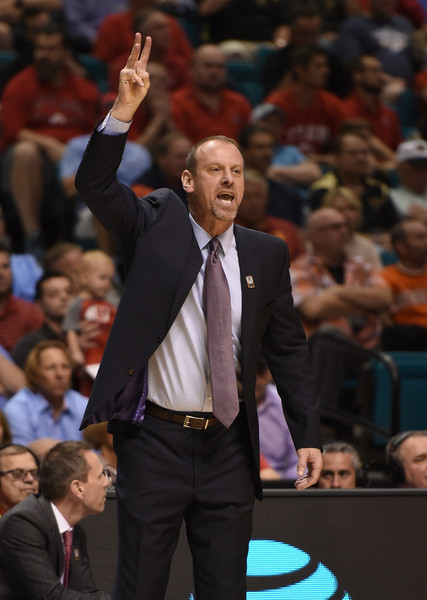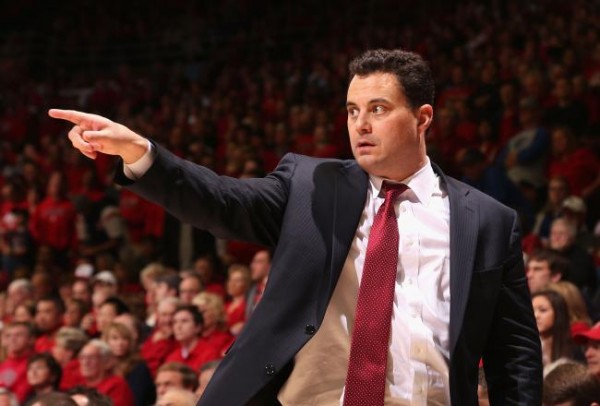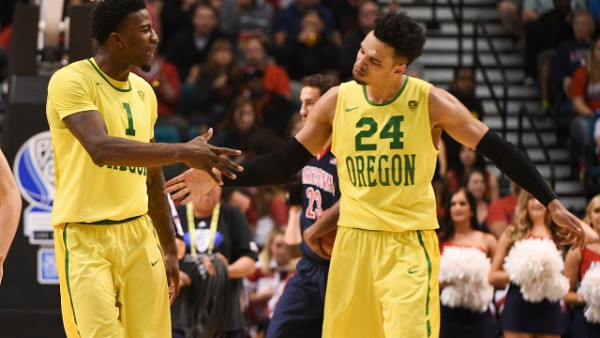Best and Worst Case Scenarios For the Pac-12’s Top Four
Posted by Andrew Murawa (@Amurawa) on March 13th, 2016If you’re a Pac-12 fan feeling nervous about Selection Sunday, here are two words of advice: don’t fret! We’re here to tell you that everything is going to work out: Seven conference teams (Oregon, Utah, California, Arizona, Colorado, USC and Oregon State) will get invitations to the Big Dance. Those first four will likely be placed among the top six seed lines, while the last three should be assigned to tougher sledding somewhere in the #7-#11 range. Washington fans? Sorry, but hopefully you’ll be able to enjoy a home NIT game. Colorado, USC, Oregon State: Be happy that you’re dancing and your teams should believe they can at least win that opener, but anything beyond that will be pure gravy. Those first four teams (Oregon, Utah, California, Arizona), however, should have higher expectations. While there are plenty of fans all over the country with unreasonably lofty hopes at this time of year, none of those four teams are insane to think about a Final Four appearance so long as everything breaks just right. What is “everything” for this quartet? And what are the scenarios that could trip them up prematurely? Let’s dig into best and worst case scenarios for each of the Pac-12’s top four teams.
Oregon
Final Four Team If: Hey, getting to the Final Four is a ridiculously difficult task (just ask Arizona fans about Frank Kaminsky and Sam Dekker) even if you have a once-in-a-generation team like these Ducks have. But Oregon is the perfect example of modern-day position-less basketball. In a seven-man rotation, they havve one true point guard type, one true big-man type, then five versatile guys who are just, you know, basketball players. They can guard almost any position, share the ball, hit jumpers, and attack the rim off the bounce. They’re also so well coached that if an opponent has a defensive weakness, you can bet the Ducks will exploit it. Offensively, they’re elite. Defensively, they’re just now rounding into a form that belies their season-long numbers. The sky is the limit here.
First Weekend Exit If: Offense isn’t a question mark here; only twice in the last 18 games have the Ducks scored less than a point per possession in a game (both against Cal, the best defensive team in the Pac-12). Defensive consistency, however, is a question. Friday night’s performance against Arizona showed that while guys like Chris Boucher and Jordan Bell are going to challenge and reject every possible shot attempt, less attention is paid to recovering those missed shot attempts. On Friday night, that meant allowing 27 offensive rebounds (for a defensive rebounding percentage of just 46 percent); for the season, it’s left Oregon’s defensive rebounding percentage at just 259th in the country. All other defensive metrics are solid, but a lack of attention to that detail could really cost them. If the Ducks wind up in the #2 seed range, teams like Pitt, Baylor or Seton Hall – solid offensive rebounding teams – could be waiting in the Second Round to take advantage of such a weakness.
Utah
Final Four Team If: Jakob Poeltl plays like the All-American he has been this season, and if teammates like Jordan Loveridge (40.5% 3FG), Brandon Taylor (33.5% 3FG) and Lorenzo Bonam (40.4% 3FG) can knock in enough open shots to dissuade opposing coaches from doubling down on the Austrian big man. Defensively, the Utes like to pack it in, in part to protect Poeltl from cheap fouls, but also in an effort to force opponents to hit tough perimeter shots.

Don’t Let Saturday Night Fool You: Larry Krystkowiak And The Utes Are Good (Ethan Miller, Getty Images)
First Weekend Exit If: They run into a team with long and athletic guards who can take advantage of perimeter defenders like Taylor (generously listed at 5’10”) and Loveridge (a 6’6” small forward on the wrong side of the sliding athleticism scale for his position). Athletic teams like Oregon (three wins by an average of 19.7 points) and Cal (a 2-1 record on the season, but an even aggregate score) have given them trouble; potential Second Round opponents like Baylor and Texas A&M could present similar problems with their overall athleticism.
California
Final Four Team If: Elite talent and athleticism wins out. There are a couple of lottery picks on this roster in Jaylen Brown and Ivan Rabb, while guys like Jabari Bird and Tyrone Wallace are good candidates to be drafted as well. Throw in sharp-shooter Jordan Mathews and a handful of terrific role players and this squad is among the top 10 teams in the nation in terms of pure, unadulterated talent.
First Weekend Exit If: Cuonzo Martin can’t harness that talent into a coherent basketball team. The Golden Bears have won nine of their last 11 games, including a 20-point home win over Oregon — that should prove this squad can play with anybody. But on the road against Arizona, the Golden Bears were the best team for 38 minutes… and lost. In Vegas against Utah, they had a 90 percent win probability with four seconds remaining in regulation… and lost. Both of those losses came to teams in the top quarter of the nation in terms of experience. Teams with less talent but more experience can get to this Cal team if they can stick around. Assuming Cal winds up in the #5 seed range, a team like Northern Iowa (ranked 35th in the nation in KenPom’s experience metric) could cause problems in the First Round; older, fundamentally solid squads like Texas A&M and Purdue could pose potential problems in the next round too.
Arizona
Final Four Team If: Of the four best Pac-12 teams, the Wildcats demand the greatest amount of imagination to envision in the Final Four. But our sport is weird. And in a weird year of parity, it would be wildly ironic if Sean Miller’s first Final Four came with one of his least talented teams. These Wildcats are insanely tough, both physically and mentally. In the crucible that is the NCAA Tournament, that may be the single most important trait that Final Four teams share: toughness. Sure, it will also take some luck. Maybe the bracket falls apart. Maybe a higher-seeded team has a poor game and a guy like Allonzo Trier or Gabe York goes nuts. But this is a program that hasn’t lost a game – a single game – by double figures in more than three calendar years. Yes, it would be a surprise if this Arizona team, of all Arizona teams, makes a Final Four. But they call it Madness for a reason. And a team with the type of toughness this squad has, a team that is congenitally required to play in close games, is more capable of taking advantage of that madness than similarly talented squads.

Sean Miller To The Final Four With This Team Would Be The Ultimate Irony (Christian Peterson, Getty Images)
First Weekend Exit If: There are obvious weaknesses here. This is not the elite defensive team of recent Arizona history. There are no absurdly transcendent athletes here. Senior forward Ryan Anderson can be neutralized by long and athletic frontcourts. Outside of Trier, there are precious few Wildcats who can get their own shots. Teams like Gonzaga, San Diego State and Wichita State are all potential #11 seeds (assuming the ‘Cats wind up around a #6 seed) who could give this team problems. If Miller game plans his way out of that First Round, there are any number of teams in the #3 seed range that could certainly end this Arizona season. But, this is Arizona. And this is Sean Miller. Counting them out is short-sighted.











































